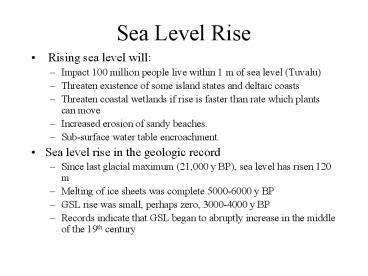Sea Level Rise - PowerPoint PPT Presentation
1 / 16
Title:
Sea Level Rise
Description:
... sea level will: Impact 100 million people live within 1 m of sea level (Tuvalu) ... Threaten coastal wetlands if rise is faster than rate which plants can move ... – PowerPoint PPT presentation
Number of Views:456
Avg rating:3.0/5.0
Title: Sea Level Rise
1
Sea Level Rise
- Rising sea level will
- Impact 100 million people live within 1 m of sea
level (Tuvalu) - Threaten existence of some island states and
deltaic coasts - Threaten coastal wetlands if rise is faster than
rate which plants can move - Increased erosion of sandy beaches.
- Sub-surface water table encroachment.
- Sea level rise in the geologic record
- Since last glacial maximum (21,000 y BP), sea
level has risen 120 m - Melting of ice sheets was complete 5000-6000 y
BP - GSL rise was small, perhaps zero, 3000-4000 y BP
- Records indicate that GSL began to abruptly
increase in the middle of the 19th century
2
- Mean sea levels at New York City in the 20th
century. Black dots represent the annual relative
sea level (RSL) measured in centimeters. The red
line represents the running 20-year mean rate of
RSL rise measured in millimeters per year.
Interannual variations are clearly so large that
portions of the record a few decades in length do
not at all reflect the long-term trend of sea
level rise, which is represented here by the
black line. All tide-gauge records display this
phenomenon.
3
(No Transcript)
4
Two scales of sea level change
- 1. Global (eustatic) sea level rise
- (a)Thermal expansion of sea water.
- The density of water decreases with
increasing temperature. - Warming atmosphere causes thermal
expansion. - 1oC increase equals 2 meters of rise
- 80 of sea level rise in last 130 yrs (0.6oC)
accounted for by thermal expansion.
5
Two scales of sea level change
- 1. Global (eustatic) sea level rise
- (b) Change in ocean basin capacity
- Dependent on spreading rate of mid-ocean
ridges - Fast spreading rate more pronounced
profile of ridge (higher ridge volume) - Sea water displaced upwards, raising sea
level at coasts. - Changes sea level 1,000 m/1 million yrs
6
Two scales of sea level change
- 1. Global (eustatic) sea level rise
- (c) The role of glaciers
- Glacial melting increases sea level.
- Sea level has risen 120 m since last glacial
maximum (21,000 y BP). - If remaining glaciers melt, sea level may rise
another 60 m.
7
(No Transcript)
8
- Land and sea ice cover over the Northern
Hemisphere at the last glacial maximum (LGM) 21
000 years ago, as modeled in references 13 and
14. The color contour over the oceans represents
the sea-surface temperatures predicted for LGM
conditions using a coupled atmosphere-ocean
general circulation model of climate system
evolution. The extent of sea ice is represented
in white for summer and as a gray extension for
winter.
9
Two scales of sea level change
- 1. Global (eustatic) sea level rise
- (d) Global sea level also affected by formation
or destruction of large, inland lakes. - (e) How is global sea level measured?
- Tidal gauges at various locations
- Satellite altimetry
10
Two scales of sea level change
- 2. Local, or relative, sea level change
- Isostatic rebound
- Caused by the melting of glaciers
- Lithosphere rises to find equilibrium in absence
of glacial load, results in observed drop in sea
level - Same process is causing New Orleans to subside
11
(No Transcript)
12
- Relative sea level rise for Fennoscandia in the
20th century derived from 70 very long-term
tide-gauge records. The contours, measured in
millimeters per year, roughly match the position
and mass of the ice sheet that covered the region
during the last glacial maximum.
13
- Relative sea level trends as a function of
latitude at sites from Key West, Florida, to
Churchill on the shore of the Hudson Bay in
Canada. The postglacial forebulge collapse peaks
at the Chesapeake Bay and shows up strongly in
the plot (Hampton Roads, Virginia, is located at
the entrance to the bay). The rates of sea-level
rise in the Mid-Atlantic region are as much as
twice the global value of about 2 mm/y.
14
- Modeling the glacial isostatic adjustment yields
present-day rates of relative sea-level (RSL)
rise for the whole globe (central panel).
Surrounding the panel are plots of RSL records at
eight geographical locations. In each plot, the
records are determined by carbon-14 dating of
individual geological indicators of past sea
level and are compared with the RSL history
predicted by the model.
15
Two scales of sea level change
- 2. Local, or relative, sea level change
- (b) Regional tectonic forces
- Subduction along an active margin causes
general uplift of the continental crust (Oregon
coast) - The continental crust along passive margins
subside, raising local sea level (Atlantic coast
of the U.S.)
16
What is the current rate of GSL rise?
- Published values range from 1.0 to 2.4 mm/y.
- If it is 1 mm/y, then global warming and thermal
expansion of the oceans is the cause and it
resulted from 0.6 C increase in global
temperatures during the last 100 years. - However, if value is closer to 2 mm/y, then
global climate models are incorrect and more
significant contributions are required from
Greenland and Anartica.































